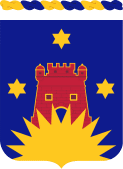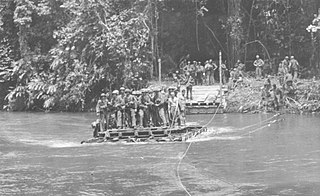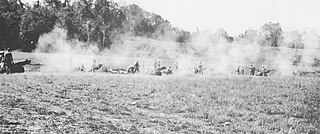
The Guadalcanal campaign, also known as the Battle of Guadalcanal and codenamed Operation Watchtower by American forces, was a military campaign fought between 7 August 1942 and 9 February 1943 on and around the island of Guadalcanal in the Pacific theater of World War II. It was the first major land offensive by Allied forces against the Empire of Japan.

Lewis Burwell "Chesty" Puller was a United States Marine Corps officer. Beginning his career fighting guerillas in Haiti and Nicaragua as part of the Banana Wars, he later served with distinction in World War II and the Korean War as a senior officer. By the time of his retirement in 1955, he had reached the rank of lieutenant general.

The Americal Division was an infantry division of the United States Army during World War II and the Vietnam War.

This is the order of battle for the Guadalcanal Campaign, called Operation Watchtower, the first major Allied offensive in the Pacific Theater of Operations in World War II. The campaign lasted from the initial American landings on 7 August 1942 until the final Japanese evacuation on 9 February 1943, a period of six months, far longer than was expected by Allied planners.

General Alexander McCarrell Patch was a senior United States Army officer who fought in both world wars, rising to rank of general. During World War II, he commanded U.S. Army and Marine Corps forces during the Guadalcanal Campaign in the Pacific, and the Seventh Army on the Western Front in Europe.

Kenneth Dillon Bailey was a United States Marine Corps officer who posthumously received the Medal of Honor for heroic conduct during action during the Battle of Guadalcanal in the Solomon Islands. He also earned the Silver Star Medal during the initial landing on Tulagi in the Solomon Islands and the Purple Heart.

The Battle of the Tenaru, sometimes called the Battle of the Ilu River or the Battle of Alligator Creek, was a land battle between the Imperial Japanese Army and Allied ground forces that took place on 21 August 1942, on the island of Guadalcanal during the Pacific campaign of World War II. The battle was the first major Japanese land offensive during the Guadalcanal campaign.

The Battle of Edson's Ridge, also known as the Battle of the Bloody Ridge, Battle of Raiders Ridge, and Battle of the Ridge, was a land battle of the Pacific campaign of World War II between Imperial Japanese Army and Allied ground forces. It took place from 12–14 September 1942, on Guadalcanal in the Solomon Islands, and was the second of three separate major Japanese ground offensives during the Guadalcanal campaign.

The Battle for Henderson Field, also known as the Battle of Guadalcanal or Battle of Lunga Point by the Japanese, took place from 23 to 26 October 1942 on and around Guadalcanal in the Solomon Islands. The battle was a land, sea, and air battle of the Pacific campaign of World War II and was fought between the Imperial Japanese Army and Navy and Allied forces, mainly U.S. Marines and Army. The battle was the last of three major land offensives conducted by the Japanese during the Guadalcanal campaign.

The Actions along the Matanikau—sometimes referred to as the Second and Third Battles of the Matanikau—were two separate but related engagements between the United States and Imperial Japanese naval and ground forces in the Pacific theater of World War II. The actions occurred around the Matanikau River on Guadalcanal Island in the southwestern Pacific during the Guadalcanal campaign. These particular engagements—the first taking place between 23 and 27 September, and the second between 6 and 9 October—were two of the largest and most significant of the Matanikau actions.

The 164th Regiment (Regional Training Institute) is a training unit of the North Dakota Army National Guard. As the 164th Infantry Regiment, it was formed in the 1920s but traced its history to North Dakota units formed in the 1900s. The regiment was the first United States Army unit to land on Guadalcanal during World War II.
Akinosuke Oka was a colonel in the Imperial Japanese Army and a commander of Japanese troops during the strategically significant Guadalcanal campaign in the Pacific theater of World War II. He was posthumously promoted to major general.
Yumio Nasu was a major general and a division commander in the Imperial Japanese Army (IJA) during World War II.

The Matanikau Offensive, from 1–4 November 1942, sometimes referred to as the Fourth Battle of the Matanikau, was an engagement between United States (U.S.) Marine and Army and Imperial Japanese Army forces around the Matanikau River and Point Cruz area on Guadalcanal during the Guadalcanal campaign of World War II. The action was one of the last of a series of engagements between U.S. and Japanese forces near the Matanikau River during the campaign.

The Koli Point action, during 3–12 November 1942, was an engagement between U.S. Marine Corps and U.S. Army forces and Imperial Japanese Army forces around Koli Point on Guadalcanal during the Guadalcanal campaign. The U.S. forces were under the overall command of Major General Alexander Vandegrift, while the Japanese forces were under the overall command of Lieutenant General Harukichi Hyakutake.

The Battle of Mount Austen, the Galloping Horse, and the Sea Horse, part of which is sometimes called the Battle of the Gifu, took place from 15 December 1942 to 23 January 1943 and was primarily an engagement between United States and Imperial Japanese forces in the hills near the Matanikau River area on Guadalcanal during the Guadalcanal campaign. The U.S. forces were under the overall command of Major General Alexander Patch and the Japanese forces were under the overall command of Lieutenant General Harukichi Hyakutake.
Tadayoshi Sano was a lieutenant general and commander in the Imperial Japanese Army (IJA) during World War II.

The Battle of Viru Harbor was a battle of the Pacific campaign of World War II that took place on New Georgia island during the New Georgia campaign from 28 June – 1 July 1943. It was one of the first actions of the campaign and involved an overland advance by elements of a Marine Raider battalion, supported by a United States Army infantry company. Supported by airstrikes, the Marines carried out an enveloping attack on the Japanese defenders around the harbor and forced them to withdraw. The harbor was subsequently used by US forces to support further operations, although plans to build a PT boat base in the area were later canceled when the harbor was found to be unsuitable.

The Battle of Bairoko was fought between American and Imperial Japanese Army and Navy forces on 20 July 1943 on the northern coast of New Georgia Island. Taking place during World War II, it formed part of the New Georgia campaign of the Pacific War. In the battle, two battalions of the US Marine Raiders from the 1st Marine Raider Regiment, supported by two US Army infantry battalions, attacked a Japanese garrison guarding the port of Bairoko on the Dragons Peninsula, advancing from Enogai and Triri. After a day long engagement, the Japanese repulsed the American assault and forced the attacking troops to withdraw with their wounded to Enogai. US forces remained in the area carrying out patrolling and intelligence gathering operations until the end of the campaign. Bairoko was eventually captured at the end of August after the airfield at Munda had been captured, and further reinforcements were sent from there towards Bairoko to clear the area from the south.
















